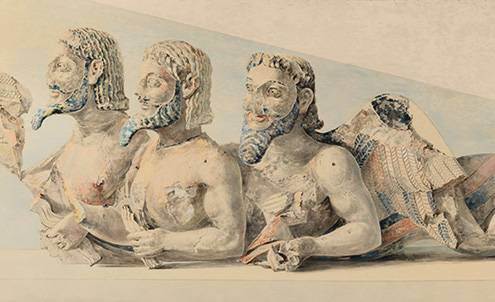
Émile Gilliéron père. Three-bodied winged figure with a snaky tail, commonly known as “Bluebeard” (detail), 1919. After a sixth-century B.C. pedimental sculpture found on the Acropolis of Athens. Watercolor, graphite, and crayon on paper. The Metropolitan Museum of Art, Dodge Fund, 1919.
Watercolors of the Acropolis at the Met The Metropolitan Museum of Art presents the exhibition ‘Watercolors of the Acropolis: Émile Gilliéron in Athens’. May 13, 2019 to January 3, 2020.]]>
Source: Metropolitan Museum of Art
The exhibition features three drawings roughly 11 feet long and two smaller examples depicting architectural sculptures with mythological subjects from the Athenian Acropolis. The sculptures decorated buildings that were destroyed in the early fifth century B.C. The watercolors demonstrate Gilliéron’s exceptional mastery of an unforgiving medium applied on an exceptionally large scale.
The five watercolors depicting sculptures from the Athenian Acropolis represent a special group by virtue of their size and evolution. Recent investigation reveals that Gilliéron père was present when the original sculptures were excavated in the 1880s. From working drawings and photographs, he later created these watercolors for sale. The three largest works depict the sculptures that are believed to have decorated the pediment of a very large temple, known as the “Hekatompedon” (the “Hundred Footer”). In the center, two lions savage a young bull. On the left, the Greek hero Herakles wrestles Triton, a sea creature; on the right, a winged, three-bodied figure with a snaky tail holds out fire, water, and a bird. The drawings of the corner groups are the same size as the original sculptures while the drawing of the animals is half the size of the original. The two smaller sculptures, from different, unidentified buildings, depict two further myths involving the Greek hero: one shows Herakles killing the Hydra of Lerna, a fearsome creature whose heads grew back as quickly as they were lopped off, and the other shows Herakles being introduced into Olympos, the home of the gods, at the end of his trials. The original sculptures date to about 575–560 B.C. and, from the time they came to light, excited interest for the colors with which they were painted in antiquity.
Related content
The Silver Caesars: A Renaissance Mystery at the Met (exhibition, 2017)
Follow us on:


